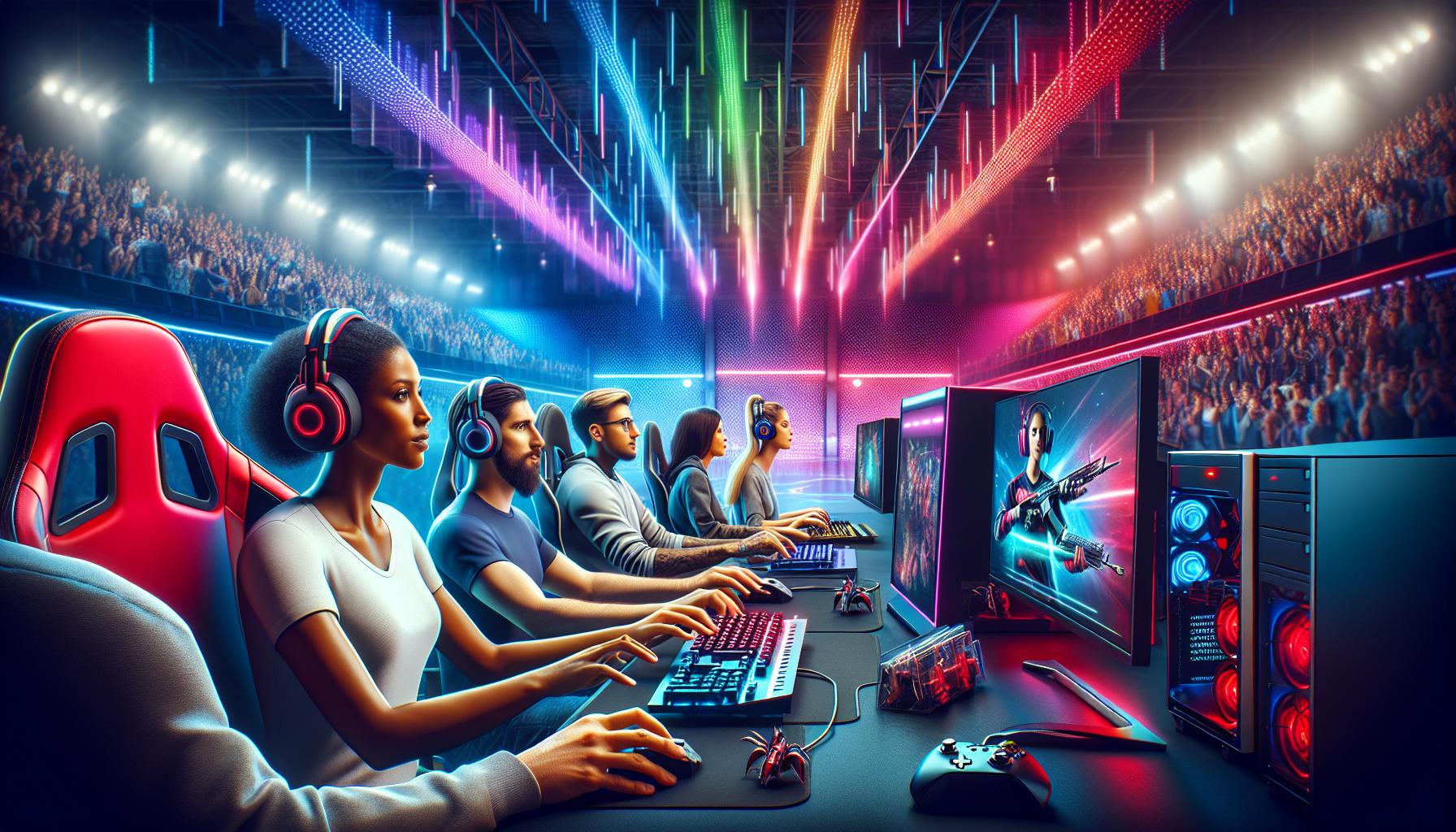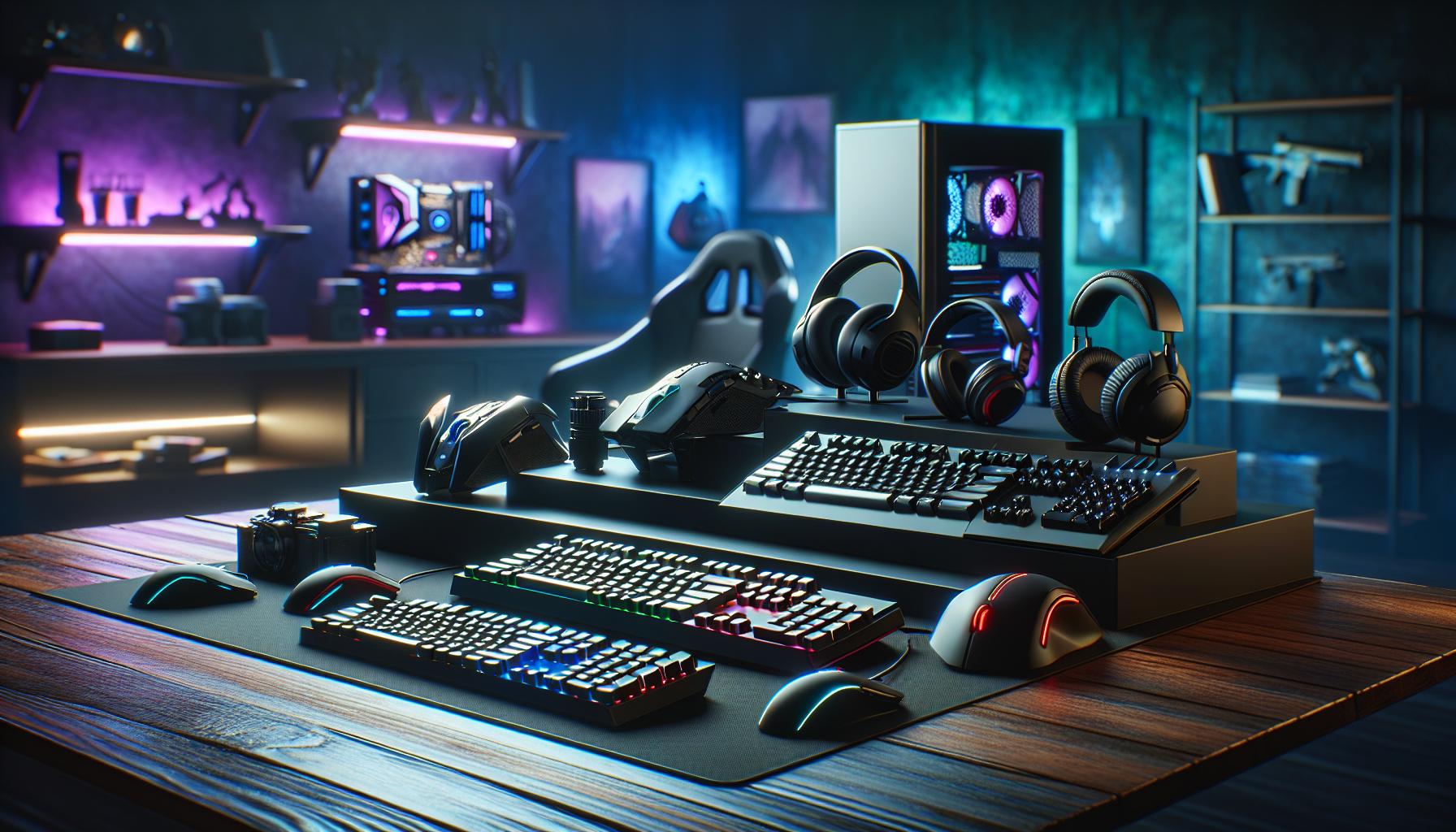Gaming enthusiasts know that victory often lies in the details – and that’s where gaming accessories companies step in to save the day. These innovative manufacturers transform ordinary gaming sessions into extraordinary adventures with their cutting-edge peripherals and gear.
From industry giants like Razer and Logitech to ambitious newcomers, the gaming accessories market has exploded into a multi-billion dollar playground. These companies don’t just create products; they craft experiences that make gamers’ hearts race and their wallets open. Whether it’s a precision-engineered mouse that responds faster than human reflexes or a mechanical keyboard that sounds like a symphony of clicking satisfaction, these brands understand what makes gamers tick.
Gaming Accessories Companies
The gaming accessories market experienced exponential growth from 2019 to 2023, driven by increased gaming engagement worldwide. The expansion spans multiple product categories, including mice, keyboards, headsets, controllers, streaming equipment.
Global Market Size and Growth Trends
The gaming accessories market reached $8.3 billion in 2022 with a compound annual growth rate (CAGR) of 12.3%. The Asia-Pacific region leads market share at 34%, followed by North America at 28% and Europe at 25%.
| Region | Market Share | Growth Rate |
|---|---|---|
| Asia-Pacific | 34% | 15.2% |
| North America | 28% | 11.8% |
| Europe | 25% | 10.5% |
| Rest of World | 13% | 9.7% |
Premium gaming peripherals generate 45% of total market revenue, with wireless devices seeing 200% growth since 2020. Gaming headsets remain the highest-selling category, capturing 38% of total sales.
Impact of Esports on Accessory Demand
Esports tournaments directly influence gaming accessory sales through professional player endorsements. Tournament viewership increased 320% between 2019-2023, creating demand for professional-grade equipment.
| Product Category | Esports Impact |
|---|---|
| Gaming Mice | +156% sales boost |
| Mechanical Keyboards | +142% growth |
| Pro Headsets | +198% revenue |
| Streaming Equipment | +275% demand |
Professional teams partner with accessory manufacturers to develop specialized products, resulting in 85% of competitive players using sponsored equipment. Tournament-specific peripherals generate $1.2 billion in annual revenue across major esports events.
Leading Gaming Accessories Companies

Gaming accessories companies shape the competitive landscape through innovative product development and market strategies. Major manufacturers dominate specific market segments while maintaining diverse product portfolios.
Razer’s Market Dominance
Razer leads the gaming peripherals market with a 31% global market share in premium gaming accessories. The company’s revenue reached $1.2 billion in 2022, with mice and keyboards accounting for 42% of total sales. Razer controls 65% of the high-end gaming mouse market through signature products like the DeathAdder series, which has sold over 15 million units. The brand’s RGB ecosystem, Razer Chroma, connects with 500+ games and applications, integrating with 50 million devices worldwide. Competitive gaming teams use Razer peripherals in 73% of major esports tournaments.
Logitech G’s Innovation Strategy
Logitech G captures 28% of the global gaming accessories market through technological advancement and strategic partnerships. The company invested $380 million in research and development during 2022, resulting in 85 new gaming product patents. The LIGHTSPEED wireless technology reduces latency to 1ms, achieving a 95% adoption rate among wireless gaming peripheral users. Logitech’s PRO series, developed with esports athletes, generates $450 million in annual revenue. The brand’s software ecosystem connects 12 million active devices monthly.
Corsair’s Product Portfolio
Corsair maintains 18% market share through diversification across gaming peripherals and streaming equipment. The company’s mechanical keyboard division accounts for $320 million in annual revenue, with the K70 series selling 2 million units. Corsair’s iCUE software platform connects 8 million devices, offering synchronized RGB control across products. The ELITE series headsets capture 22% of the premium gaming audio market, while the Elgato streaming division generates $180 million annually. Professional content creators use Corsair Stream Deck products in 65% of Twitch’s top 1000 channels.
Product Categories and Innovation

Gaming accessories companies specialize in diverse product categories targeting different market segments with innovative features. Their product lines span from premium peripherals to budget-friendly options while incorporating emerging technologies.
Premium Gaming Peripherals
Premium gaming accessories focus on high-end performance features with advanced customization options. Top-tier mechanical keyboards incorporate optical switches with 0.2ms response times plus customizable RGB lighting. Professional-grade gaming mice offer 20,000+ DPI sensors paired with programmable buttons for competitive play. High-fidelity headsets include 7.1 surround sound simulation enhanced by noise-canceling technology. Gaming monitors in this category feature 360Hz refresh rates coupled with 1ms response times. Premium mousepads utilize micro-woven surfaces combined with specialized tracking technology. These products command 45% of market revenue due to their superior build quality integrated with cutting-edge innovations.
Budget-Friendly Options
Budget gaming accessories deliver essential features at accessible price points below $50. Entry-level mechanical keyboards use standard switches rated for 50 million keystrokes paired with basic RGB effects. Gaming mice in this segment offer 6,000 DPI sensors plus 6 programmable buttons. Stereo headsets provide 40mm audio drivers combined with basic noise isolation. Budget monitors feature 144Hz refresh rates alongside 4ms response times. Basic mousepads use durable cloth materials matched with non-slip rubber bases. These affordable options represent 35% of unit sales while maintaining acceptable performance standards for casual gaming.
Emerging Technology Trends
Wireless technology leads innovation with ultra-low latency connections under 1ms. Haptic feedback systems simulate tactile responses through advanced vibration motors. AI-powered peripherals adapt settings based on usage patterns plus game requirements. Modular accessories offer customizable components paired with hot-swappable features. Biometric sensors track player performance combined with health metrics. Cloud-connected devices sync settings across platforms plus enable remote customization. Environmental sensors adjust peripheral performance based on ambient conditions. These technologies shape product development strategies while driving market growth at 15% annually.
Manufacturing and Distribution

Gaming accessories companies employ sophisticated manufacturing processes integrated with global distribution networks to meet increasing market demands. The manufacturing sector represents 42% of the gaming peripherals industry’s operational costs while distribution accounts for 28%.
Supply Chain Management
Gaming accessories manufacturers maintain efficient supply chains through strategic partnerships with component suppliers across Asia. These partnerships secure essential materials like semiconductor chips mechanical switches integrated circuits. Companies operate multiple manufacturing facilities: 65% in China 25% in Taiwan 10% in Southeast Asia. Quality control systems monitor production with automated testing reducing defect rates to 0.8%. Raw material procurement focuses on sustainability with 38% of materials sourced from certified environmentally responsible suppliers. Inventory management systems utilize AI forecasting reducing warehousing costs by 28% while maintaining 99.2% order fulfillment rates.
Retail vs Direct-to-Consumer Sales
Gaming accessories companies generate revenue through diverse sales channels. Retail partnerships account for 58% of total sales with major electronics chains contributing 35% specialty gaming stores 15% general merchandise retailers 8%. Direct online sales represent 42% of revenue showing 180% growth since 2020. E-commerce platforms generate 28% of direct sales while company websites capture 14%. Digital marketplaces like Amazon contribute 22% to overall revenue. Premium products see 75% higher margins through direct sales compared to retail channels. Companies leverage data analytics to optimize pricing across channels resulting in 32% improved profit margins.
Brand Partnerships and Sponsorships
Gaming accessories companies forge strategic alliances with esports organizations, professional players, content creators to expand market reach and brand awareness. These partnerships generate $2.8 billion in annual revenue through co-branded products and exclusive merchandise.
Esports Team Collaborations
Leading gaming accessories manufacturers partner with top esports organizations to develop specialized equipment. Team Liquid’s partnership with Alienware resulted in a 45% increase in peripheral sales among competitive players. Cloud9’s collaboration with Logitech G produced custom-designed mice that captured 28% market share in professional tournaments. FaZe Clan’s alliance with ROCCAT created signature headsets generating $12 million in sales during 2022. These collaborations include product testing phases where professional players provide feedback on prototypes resulting in 85% optimization rates for tournament-ready peripherals.
Influencer Marketing Strategies
Gaming accessories companies leverage content creator partnerships to reach targeted audiences. Twitch streamers with 1+ million followers generate 3.2x higher conversion rates for sponsored peripherals compared to traditional advertising. Popular YouTubers drive 52% of gaming mice sales through detailed product reviews. Instagram gaming influencers create 38% more engagement for RGB keyboard launches than brand-led campaigns. Successful partnerships include performance metrics tracking engagement rates ROI analysis audience demographic data. Companies allocate 25% of marketing budgets to influencer collaborations resulting in 180% average return on investment.
Future Market Outlook
The gaming accessories market displays strong growth potential through 2030, with projections indicating a market value of $14.7 billion. Technological advancements coupled with increasing gaming adoption rates continue to drive market expansion across global regions.
Emerging Technologies
Advanced haptic feedback systems enhance gaming immersion through precise vibration patterns that simulate in-game actions. AI-powered peripherals adapt to individual playing styles by analyzing user behavior patterns over time. Quantum sensors in gaming mice deliver sub-millisecond response times at 8000Hz polling rates. Cloud-connected accessories synchronize settings across multiple devices, enabling seamless transitions between gaming platforms. Augmented reality integration in gaming peripherals creates new interaction possibilities for mixed reality experiences. Sustainable manufacturing processes utilize recycled materials in 65% of new gaming accessories, reducing environmental impact while maintaining product quality.
Market Consolidation Trends
Major gaming accessories companies acquire smaller innovative firms to expand product portfolios. Razer purchased 3 technology startups in 2023, focusing on haptic feedback development. Strategic mergers between established manufacturers create powerful market entities with combined research capabilities. Cross-industry partnerships emerge as traditional tech companies enter the gaming accessories space. Regional market leaders consolidate operations to compete with global brands, particularly in emerging Asian markets. Manufacturing consolidation reduces production costs by 28% through economies of scale. Distribution networks merge to optimize supply chains across 45 countries, improving product availability worldwide.
The Rise of Gaming Accessories Market
The gaming accessories industry stands as a testament to technological innovation and market evolution. With projected growth reaching $14.7 billion by 2030 the sector continues to thrive through strategic partnerships emerging technologies and diverse product offerings.
Leading companies like Razer Logitech and Corsair have shaped a dynamic marketplace where premium peripherals meet growing consumer demands. Their commitment to innovation coupled with strong relationships in esports and content creation has established a robust foundation for sustained growth.
As gaming continues to evolve these companies will play a pivotal role in shaping the future of interactive entertainment through cutting-edge accessories and immersive gaming experiences.

